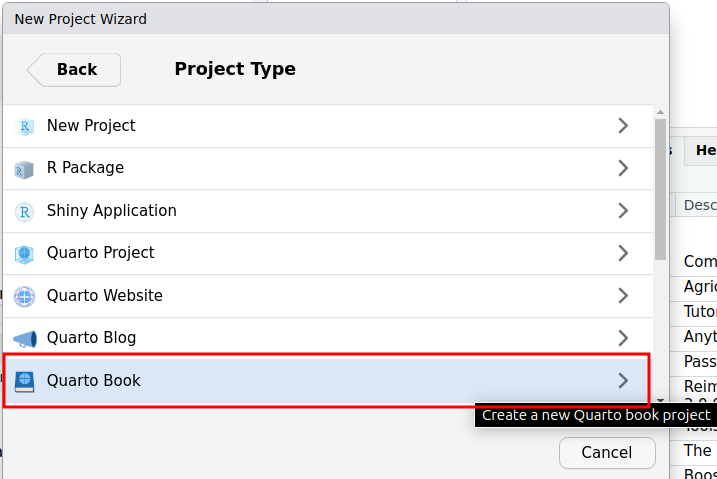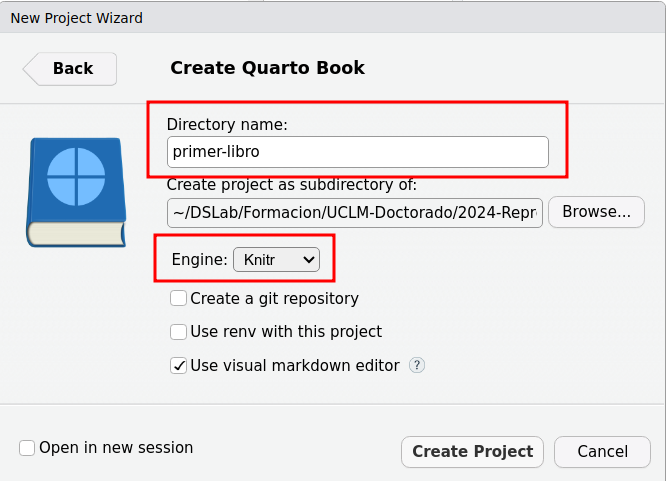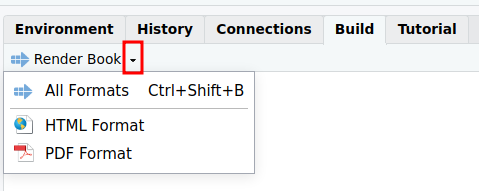5 Books
Now that we know all the basic elements for creating individual literary programming documents with Quarto, the natural evolution is to ask ourselves if we can manage ordered collections of documents in a single project to, for example, create a book, a laboratory notebook, or an experiment log.
Book-type projects in Quarto are the answer to these needs, allowing us to group and organize several individual documents in a single website or a single volume (PDF) for publication.
5.1 Creating a book project
The first step is to create a book project, using the IDE of our choice, for example, RStudio. The Figure 5.1 shows the RStudio interface for creating a new book project with Quarto. As usual, we select a name for the directory that stores the project as shown in the Figure 5.2.


5.2 Configuration options
Unlike individual documents, in projects such as book type projects that group several documents (.qmd files) into a single collection, we can specify global configuration options for the entire project in a separate _quarto.yml file, which must be present in the root directory of our project.
By default, the configuration options presented by this file in a newly created project of this type are the following.
project:
type: book
book:
title: "First book"
author: "Norah Jones"
date: "20/12/2024"
chapters:
- index.qmd
- intro.qmd
- summary.qmd
- references.qmd
bibliography: references.bib
format:
html:
theme: cosmo
pdf:
documentclass: scrreprt
editor: visualThe new elements in this list of options are:
project–>type: book: Allows you to indicate the type of project you want to set up so that Quarto adjusts its behavior and can group a collection of documents. It activates the interpretation of options related to this type of project.book: New category of options that indicates the specific configuration applicable to all documents in this project, as well as global options. For instance, the title, author, and date will be displayed on a special cover page.chapters: New subcategory of options that allows you to insert a list of file names that contain the different sections or chapters of your book.
We must keep in mind that the sections or chapters will be processed in exactly the same order in which they appear in this list, so it is important to pay attention to this order.
5.3 Home page (preface)
In addition to the new _quarto.yml file, another file called index.qmd is generated which contains the material that will be presented as the cover of the book or collection of documents.
A general file is also created in other types of projects, for example for the home page of a website generated with Quarto. It is in this cover page that the general configuration information is contained (title, authors, date, etc.).
The content of this file is the same as in any other document, following the same Quarto syntax rules for .qmd files that we have already seen.
It should also be noted that the title of this cover page is not usually numbered and, therefore, it is common for it to be configured as:
# Preface {.unnumbered}5.4 Writing tools
All the writing tools we have already seen in the Chapter 4 can be used in the case of chapters in a book. It is important to note that links to sections also work from documents in other sections or chapters of the book, even if they are in a different file.
5.4.1 Book structure
In addition to standard chapters, we can also organize the book’s content into parts (which group together related chapters), as well as appendices, presented after the main content of the book to provide additional material.
Let’s look at an example of a book configuration that includes several parts and that we can integrate into the rest of the project configuration, within the _quarto.yml file.
chapters:
- index.qmd
- preface.qmd
- part: dice.qmd
chapters:
- basics.qmd
- packages.qmd
- part: cards.qmd
chapters:
- objects.qmd
- notation.qmd
- modifying.qmd
- environments.qmdIt is important to note that in this case the part option can accept either a file with a .qmd extension (as in the example), or a quoted string that simply indicates a title for the part.
Now we present an example for appendices.
book:
title: "mybook"
author: "Jane Doe"
date: "5/9/2021"
chapters:
- index.qmd
- intro.qmd
- summary.qmd
- references.qmd
appendices:
- tools.qmd
- resources.qmdIt is important to note that these configuration options generate the appropriate output (parts and appendices) both in the case of HTML websites and when generating a PDF document, following in the second case the standard LaTeX syntax to indicate the structure of the document.
5.5 Managing references
As mentioned above, internal references (to figures, tables, equations, and other sections of the document, among other items) work exactly the same as in individual documents (see Section 4.5.1), with the added advantage that in a book that combines different chapters, the numbering of all items is updated to reflect the chapter number as a prefix to the item number (e.g., “Figure 1.2” for the second figure in chapter 1).
It is important to note that for automatic item numbering to work properly, it is important that items begin with the appropriate prefix (#sec- for sections, #fig- for figures, etc.).
5.6 Project preview
To preview on our local machine the project we have created using RStudio, we must select the Build tab in the upper right panel and press the Render Book button to generate all the output formats that are configured in the _quarto.yml file, as shown in Figure 5.3. There is also the option to select only one of these output formats by carefully clicking on the small arrow next to the “Render Book” button, to display a list of output format options and select one of them, as shown in Figure 5.4


5.7 Publication options
There are several [publishing options] to make our book or collection of documents available to other users, including:
- Quarto Pub.
- GitHub Pages, very convenient if we want an integrated solution for version management of our project’s source code.
- Netlify, a professional web publishing platform that allows more configuration and setup options.
It is also possible to use other services to publish documents, books, and websites with Quarto, including GitLab (an alternative to GitHub), although they will not be as automated and integrated with the tools offered by Quarto as the previous options.
5.8 Customisation and templates
As we have explained for individual documents, analogous configuration options can be used to customize the style and design theme that we can apply to our book or collection of documents, both in the HTML website version and in the PDF output version.